As loving pet parents, we want to share everything with our furry companions, especially when they give us those irresistible puppy-dog eyes during mealtime. However, many human foods that are perfectly safe, and even healthy, for us can be incredibly dangerous or toxic for dogs. Canine digestion and metabolism operate very differently from our own, meaning some substances can build up rapidly in their systems, leading to severe illness or even death. Understanding what foods can dogs not eat list is not just important, it’s a critical aspect of responsible pet ownership.
Pet poisonings are a real and unfortunately common threat, with hundreds of thousands occurring in the United States annually. While not all incidents are food-related, common household foods are a significant contributor. This guide aims to equip you with essential knowledge, serving as your ultimate “cheat sheet” to help keep your beloved canine safe and healthy.
Why Certain Foods Are Toxic to Dogs
The question of what dogs can and cannot eat fundamentally comes down to their distinct physiological makeup. Dogs process certain substances very differently than humans do. For instance, theobromine and caffeine found in chocolate are metabolized much slower by dogs, leading to a rapid accumulation in their system that can be fatal.
Similarly, while the fleshy part of cherries might be harmless, the cyanide contained in their pits, stems, and leaves can pose a serious problem if ingested in large quantities. Moreover, fruit pits can cause digestive upset and potential obstructions in the gastrointestinal tract due to their indigestible nature.
Food toxicity can also be influenced by a dog’s size, breed, and existing health conditions. A small dog, for example, will be more severely affected by a small amount of a toxic substance than a larger dog. Therefore, it is always crucial to consult your veterinarian if you have any uncertainties or questions regarding foods your dog should avoid. Their expert advice can help prevent serious health complications.
List of Common Foods Dogs Cannot Eat
Many everyday household foods are dangerous, and often toxic, to dogs. Some of the most frequently encountered culprits include alcohol, avocados, macadamia nuts, grapes and raisins, xylitol, and chocolate. It is imperative that your dog avoids all the foods detailed below, but remember that this is not an exhaustive list. Always err on the side of caution.
1. Alcohol
Due to their smaller size compared to humans, alcohol can have a far deadlier effect on dogs. Even minimal amounts can cause harm, with the risk increasing significantly for smaller pets. Symptoms of alcohol poisoning in dogs mirror those in humans, including vomiting, breathing difficulties, coma, or even death. Immediate veterinary attention is crucial if you suspect alcohol ingestion.
2. Apple, Apricot, Cherry, and Plum Seeds/Pits
While the flesh of apples is safe for dogs, the core and seeds are not. Apple seeds contain cyanide, and though small amounts might not be immediately harmful, it’s best to remove the core and seeds entirely. Apricot, cherry, peach, and plum seeds and pits also contain cyanide, which can lead to severe symptoms such as vomiting, irregular and rapid heartbeat, seizures, coma, and ultimately death, by impairing the red blood cells’ ability to carry oxygen.
3. Avocado
Avocados are not a suitable food choice for dogs. They contain a fungicidal toxin called persin, which can cause vomiting and diarrhea in some animals. While studies on dogs haven’t consistently replicated the severe myocardial damage observed in other species, it’s still best to avoid feeding them avocado. Furthermore, an intact avocado pit presents a significant choking hazard and can cause a dangerous gastrointestinal obstruction.
4. Broccoli
Broccoli contains isothiocyanates, compounds that can be harmful to pets in very large quantities. While small, occasional amounts might be acceptable, it’s generally safer to avoid broccoli given the abundance of other healthy and safe food options. Additionally, broccoli stalks can occasionally become lodged in a dog’s throat, leading to an obstruction.
5. Caffeine and Coffee Grounds
Caffeine contains methylxanthines, which can cause potentially fatal symptoms such as diarrhea, vomiting, seizures, and an irregular heartbeat. Ingesting coffee grounds or high-caffeine drinks can cause a dog’s heart rate to accelerate, leading to tremors, arrhythmia, difficulty breathing, and other serious symptoms. Keep all caffeinated products out of reach.
6. Chicken and Turkey Skin, Ham, and Other Fatty Cuts of Meat
Fatty cuts of meat, ham, and fatty items like chicken or turkey skin should be discarded rather than given to pets as treats. Their high-fat content can trigger acute pancreatitis, a life-threatening illness with severe complications. It is also crucial to avoid giving dogs turkey and chicken bones, as they can splinter, leading to obstructions or damage to the stomach or intestines, potentially causing a fatal abdominal infection.
7. Chocolate
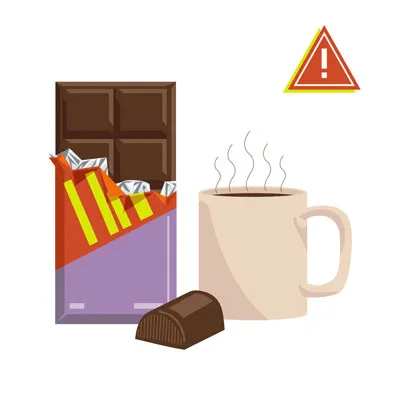 Assorted chocolate bars and pieces, illustrating the various types that are toxic to dogs, ranging from milk to dark chocolate.
Assorted chocolate bars and pieces, illustrating the various types that are toxic to dogs, ranging from milk to dark chocolate.
Chocolate toxicity is a frequent cause of pet poisoning, especially during holidays. Your dog should never consume any chocolate product. Chocolate contains theobromine, a lethal component, with darker chocolates containing higher concentrations. Chocolate also has caffeine, and some sugar-free chocolates may contain xylitol, both of which are highly toxic to dogs. Dogs and cats cannot metabolize chocolate as effectively as humans. Symptoms of chocolate ingestion include hyperactivity, vomiting, diarrhea, pancreatitis, abnormal heart rhythm, and seizures. Contact your vet immediately if your dog eats any amount of chocolate.
8. Grapes and Raisins
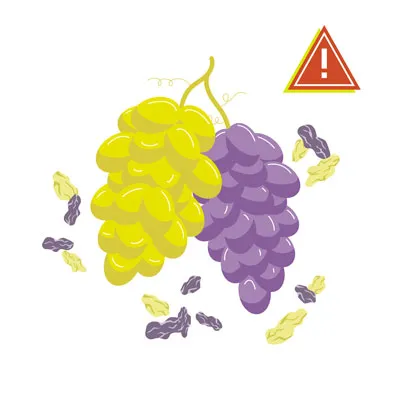 A bowl of fresh red grapes next to a small pile of dried raisins, emphasizing these common fruits are dangerous for dogs.
A bowl of fresh red grapes next to a small pile of dried raisins, emphasizing these common fruits are dangerous for dogs.
Grapes and raisins are exceptionally dangerous for dogs and can cause severe problems, including kidney failure, due to their tartaric acid content. Even a few bites can wreak havoc. Symptoms of grape or raisin poisoning include vomiting, diarrhea, loss of appetite, changes in urination, or complete absence of urine production.
9. Macadamia Nuts, Almonds, and Pistachios
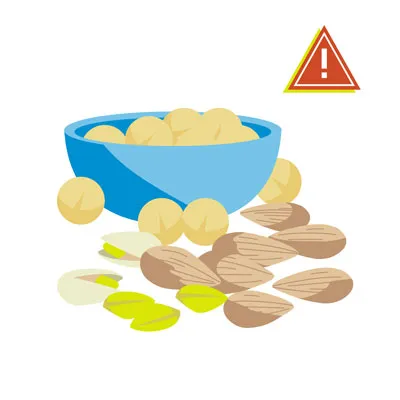 A small pile of macadamia nuts with almonds and pistachios scattered nearby, highlighting a group of nuts toxic or problematic for dogs.
A small pile of macadamia nuts with almonds and pistachios scattered nearby, highlighting a group of nuts toxic or problematic for dogs.
Macadamia nuts can cause numerous painful symptoms in dogs, such as weakness, overheating, and vomiting. Although the exact mechanism of toxicity is not fully understood, these nuts are considered highly toxic. As few as six nuts can cause severe poisoning in a small dog. While macadamia nuts are the most dangerous, other nuts like pistachios and almonds can pose choking hazards or become problematic if seasoned or spiced.
10. Milk and Dairy Products
Milk and other dairy products should be given with extreme caution. While some dogs tolerate them well, many are lactose intolerant or allergic, experiencing diarrhea and gas from cow’s milk. Ice cream is particularly bad due to its high sugar and fat content; frozen healthy fruits are a better alternative. Small quantities of lower-fat cheese can be acceptable as an occasional treat, but consult your veterinarian for advice.
11. Mushrooms
It is always safest to prevent your dog from eating mushrooms. Wild mushrooms can contain a variety of toxins that may lead to kidney and liver failure, vomiting, diarrhea, hallucinations, and red blood cell damage. While washed white mushrooms from grocery stores might be safe, it’s generally wiser to choose a different treat to eliminate any risk.
12. Nutmeg and Cinnamon
Dogs should never be fed foods containing nutmeg. This spice can induce hallucinations and severe vomiting due to the compound myristicin, especially in high doses or in smaller dogs. If your dog ingests any amount of nutmeg, seek veterinary guidance immediately. Cinnamon should also be avoided, not primarily for toxicity, but because it can irritate your dog’s mouth and potentially lead to dangerous low blood sugar levels.
13. Onions, Garlic, Chives, and Leeks
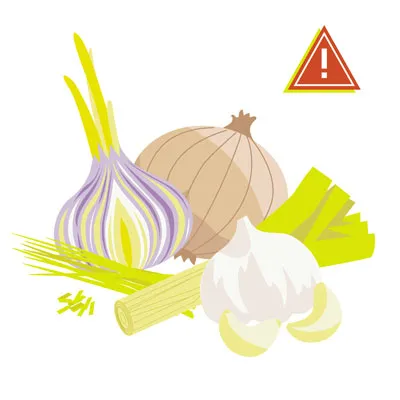 Fresh onions, garlic cloves, green chives, and leeks arranged together, representing the Allium family of plants that are toxic to dogs.
Fresh onions, garlic cloves, green chives, and leeks arranged together, representing the Allium family of plants that are toxic to dogs.
Many pet owners are unaware that herbs from the allium family, including onions, garlic, chives, and leeks, are unsafe for dogs. These plants contain sulfoxides and disulfides, which can damage red blood cells and cause anemia in both dogs and cats. Onion and garlic powders are commonly found in processed foods, so always read labels carefully. All allium plants can cause potentially fatal anemia, with certain Japanese breeds like Akitas and Shiba Inus being particularly sensitive.
14. Salt
Excessive salt intake can disrupt the fluid balance in a dog’s cells, leading to tremors, seizures, diarrhea, or even coma. Whether it’s rock salt, homemade play dough, or potato chips, resist those pleading eyes and do not jeopardize your dog’s health with salty items.
15. Spicy Food
Keep all spicy foods away from your dog. Hot and spicy ingredients can cause vomiting, stomach ulcers, or diarrhea, resulting in significant pain for your pet and potentially costly emergency veterinary visits.
16. Sugar-Free Gum and Candy (Xylitol)
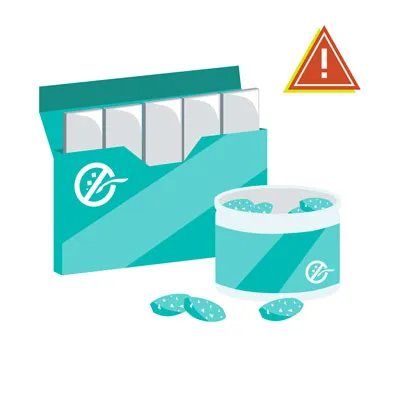 A close-up of various sugar-free gum and candy packages, highlighting products that often contain xylitol, a dangerous artificial sweetener for dogs.
A close-up of various sugar-free gum and candy packages, highlighting products that often contain xylitol, a dangerous artificial sweetener for dogs.
Xylitol is an artificial sweetener found in many human foods, including sugar-free gum, candies, and baked goods. In dogs, even small amounts can cause a rapid and dangerous drop in blood sugar, leading to weakness, seizures, and potentially liver failure. Poisoning cases involving xylitol are on the rise, with the amount in just five pieces of gum being potentially fatal to a 65-pound dog.
17. Tomatoes and Raw Potatoes
Tomatoes and potatoes fall into the category of “safe in some forms, unsafe in others.” A ripe, red tomato is generally fine. However, the green parts of the tomato plant, including green, unripe tomatoes, contain solanine, which is toxic to dogs. Similarly, baked or boiled potatoes without additives are safe in small quantities, but raw potatoes contain solanine and are toxic.
18. Tobacco
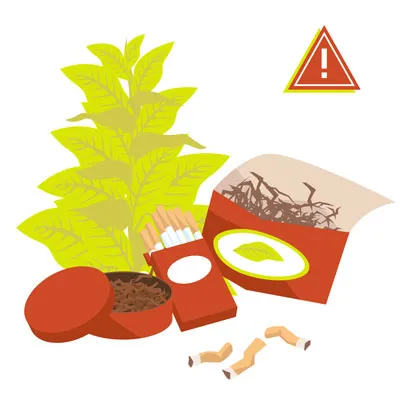 Loose tobacco and a few cigarette butts in an ashtray, representing nicotine-containing products that are highly toxic to dogs.
Loose tobacco and a few cigarette butts in an ashtray, representing nicotine-containing products that are highly toxic to dogs.
Tobacco is extremely dangerous for dogs. Exposure to nicotine-containing products can cause vomiting, diarrhea, rapid or labored breathing, agitation, abnormal heart rate, wobbliness, muscle weakness, fluctuations in blood pressure, seizures, and tremors. More significant exposure can lead to blue gums, coma, and even death. Due to dogs’ curious nature, they might encounter discarded cigarettes or ashtray contents. If your dog ingests tobacco, act immediately and take them to a veterinarian.
19. Yeast and Raw Dough
 Raw dough rising in a bowl with a packet of yeast beside it, illustrating the danger these pose to dogs.
Raw dough rising in a bowl with a packet of yeast beside it, illustrating the danger these pose to dogs.
Yeast and raw dough are unsafe for dogs for several critical reasons. Raw dough can expand rapidly in a dog’s stomach, causing severe pain, and potentially life-threatening torsion or rupture of the stomach. Furthermore, the yeast and sugar in raw dough ferment, producing alcohol, which can lead to alcohol toxicity. This condition requires immediate medical intervention and can quickly become fatal.
20. Raw Meat
Never feed your dog raw or undercooked meat. Raw meat can carry harmful bacteria such as Salmonella or E. coli, which can sicken dogs just as they do humans. Additionally, bones in raw meat pose a significant choking hazard and can splinter, causing internal injuries.
21. Rhubarb
Rhubarb, commonly found in desserts, is not safe for pets. Its leaves contain soluble calcium oxalate crystals. If ingested in sufficient quantities, these crystals can bind with calcium in the body, causing a dangerous drop in calcium levels and potentially leading to renal failure. Symptoms include tremors, weakness, drooling, bloody urine, changes in thirst and urination, and vomiting.
22. Star Fruit
Similar to rhubarb, star fruit also contains soluble calcium oxalate crystals. Therefore, it is best to prevent your dog from snacking on this fruit to avoid potential health complications.
23. Flavored Water and Seltzer Water
Always opt for fresh, clean water for your dog over anything flavored or carbonated. Seltzer and flavored waters may contain added ingredients like sugar or salt that are dangerous for pups. While plain seltzer water might be acceptable in very small, urgent amounts, it can cause gas and bloating. Sticking to plain water is always the safest choice for your pet.
13 Foods Safe for Dogs
While the list of foods dogs cannot eat is extensive, there’s also a considerable list of what can dogs have to eat safely and enjoyably! Some of the safest and most popular choices include small amounts of dehydrated chicken or beef, apples (without the core), green beans, and carrots.
Here are some common foods that are generally safe for your dog to eat. This list is not exhaustive but provides a great starting point for healthy treats.
1. Apples, Oranges, and Bananas
The fleshy parts of apples, excluding the toxic cores and seeds, are perfectly fine for dogs. Always remove the core and cut the apple into small pieces to prevent choking. Oranges are safe in small amounts, and bananas (peeled) can be a tasty treat in moderation.
2. Blueberries and Blackberries
Blueberries are excellent, antioxidant-rich treats that many dogs love. They also provide fiber, phytochemicals, and vitamin C, all beneficial for your pup’s health.
3. Cantaloupe, Mango, Peaches, Pears, Pineapples, and Watermelons
Many fruits can be safely enjoyed by your dog! Cantaloupe is a great option. Watermelon, without rinds and seeds (even pale seeds in seedless varieties to avoid choking), is hydrating and refreshing on warm days. Mangoes, peaches, pears, and pineapples are also safe in moderation, provided you remove all seeds, pits, and cores.
4. Carrots, Cucumber, and Celery
When looking for healthy vegetable options, remember the three C’s: carrots, cucumbers, and celery. These low-calorie vegetables are particularly beneficial for overweight dogs. Bite-sized carrot pieces offer a satisfying crunch, celery can help with bad breath, and cucumber slices provide vitamins and minerals with minimal carbs and fats.
5. Cheese
While general milk and dairy products can be problematic, small amounts of cheese are usually fine if your dog isn’t lactose intolerant. Opt for lower-fat varieties, like mozzarella, as a treat, and consult your veterinarian for the best choices.
6. Eggs
Fully cooked eggs are a nutritious and enjoyable treat for dogs. Scrambled eggs can even help soothe an upset stomach and are an excellent source of protein.
7. Peanuts, Peanut Butter, and Cashews
Peanuts and cashews are safe for dogs in small quantities. Due to their high-fat content, moderation is key. Ensure they are unseasoned, unflavored, and unsalted. Peanut butter, in moderation, is a delicious, high-protein treat. Always choose unsalted varieties and explicitly avoid any sugar-free options containing xylitol.
8. Popcorn and Corn
Air-popped, unsalted, and unbuttered popcorn can be a tasty treat. Carefully check for unpopped kernels to prevent choking. Similarly, corn removed from the cob is acceptable when served plain, without butter, salt, or spices.
9. Coconut and Honey
In small amounts, coconut (including coconut milk and oil) is generally fine for dogs. It contains lauric acid and may even aid with allergies. However, some dogs might experience an upset stomach from fresh coconut or coconut milk, so use cautiously. Avoid coconut water and the furry shell (choking hazard). Honey, in moderation, is also safe and offers beneficial vitamins and minerals.
10. Shrimp and Fish
Plain, fully cooked shrimp makes a great choice for your dog. Ensure the shell, head, tail, and legs are removed, and avoid any seasoned, salted, or buttered preparations. Fish, particularly salmon and sardines, is also permissible. It must be plain, fully cooked, and boneless. A good guideline is to offer fish no more than twice a week. Plain, canned tuna, packed in water (not oil), is safe in moderation to avoid excessive mercury and salt.
11. Turkey
Turkey meat is healthy and safe for dogs once the skin, fat, and bones are removed. Small bites of plain, unseasoned, and unsalted turkey make a delicious, protein-rich treat.
12. Grains, Wheat, and Quinoa
Grains like wheat and other varieties, similar to corn, are generally fine in moderation. Quinoa is a healthier option compared to many other fillers. Monitor for any signs of allergic reactions.
13. Green Beans
Many dogs enjoy green beans, whether raw, steamed, or from a can. They are safe, tasty, and healthy. Opt for plain green beans without added spices, oils, or salt, and cut them into small bites to prevent choking. Knowing what can dogs eat for dinner can help in meal planning.
What Dogs Are Most at Risk if They Consume Toxic Foods?
While all dogs should avoid toxic foods, certain factors increase a dog’s risk if they ingest something harmful:
- Small breeds vs. large breeds: Smaller dogs are more vulnerable due to their lower body weight, making substances like chocolate particularly dangerous.
- Puppies: Young dogs have less developed digestive and immune systems, putting them at greater risk from certain substances.
- Elderly dogs: Older dogs may face higher risks due to existing health conditions.
- Dogs with pre-existing conditions: Conditions like diabetes or kidney disease can significantly increase a dog’s vulnerability to toxic foods.
How To Prevent Dogs from Eating Toxic Foods
Accidents can happen, but proactive measures can significantly minimize the risk of your beloved pup encountering unsafe human food:
- Store foods out of reach: Keep all toxic foods on high shelves or securely locked in cabinets that your dog cannot access.
- Avoid feeding dogs from your plate: Never feed your dog from your plate or while you are cooking, even if it’s just a small treat. It is safest to only give treats specifically formulated for dogs.
- Educate family members and guests: Inform everyone in your household, including children and visitors, that they should never sneak food to your dog, regardless of how tempting it may be.
- Be careful during holidays: Exercise extra caution during busy holiday seasons. The hustle and bustle can lead to a lapse in vigilance when cooking and entertaining.
If, despite your precautions, your dog eats something toxic, being prepared to act swiftly is crucial. Keep emergency veterinary contact information readily accessible (available 24/7, including holidays) and have the number for poison control.
What To Do if Your Dog Eats Something Toxic
If you suspect your dog has ingested toxic food, seek help as quickly as possible. Familiarize yourself with the common symptoms of food toxicity, which vary depending on the substance but can include listlessness, distress, pain, vomiting, bloody stools, or a hard, bloated stomach (which can indicate a life-threatening condition).
If you observe these symptoms:
- Call your veterinarian or poison control immediately. Time is critical for successful treatment and shorter hospitalization.
- Be ready with crucial information such as the type of food eaten, the estimated amount consumed, and the time of ingestion.
- Avoid home remedies unless explicitly advised by your veterinarian, as remedies vary by toxin, and even inducing vomiting can be harmful in certain situations.
Dog Care Story: Helping You Keep Your Dog Healthy
From household toxins to dangerous foods, it can be challenging to keep track of everything your dog shouldn’t get into. Dogs don’t always have the most discerning taste, but by following this guide and remaining vigilant, you can help safeguard your canine companion from harmful foods.
The good news is that there are many safe and healthy foods your dog can enjoy! Discover which ones on our approved list your dog loves, and offer them as well-deserved treats. If you are ever unsure about any food, always consult with your veterinarian for expert advice.
